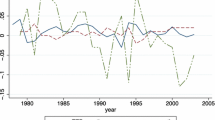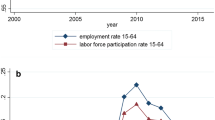Abstract
We analyse the pace and patterns of job reallocation in Ukraine using 1992–2000 panel data on nearly the universe of continuing manufacturing firms inherited from the Soviet Union. Employment growth displays a substantial increase in heterogeneity during this transition period, with a corresponding rise in excess job reallocation. Unlike data for Soviet Russia in the 1980s, Ukrainian job reallocation in the 1990s was clearly productivity enhancing, both within and across industries. The speed of the increase in reallocation and its effect on aggregate productivity was somewhat slower than in Russia, however, perhaps reflecting the more ‘gradualist’ reform strategy in Ukraine.

Similar content being viewed by others
Notes
This view is characteristic of the so-called ‘optimal speed of transition’ literature. See, for instance, Aghion and Blanchard (1994).
See, for example, Boeri (2000). Studies of worker flows in transition economies include, among others, Brown and Earle (2003), Earle (1997), and Kapeliushnikov (1997). Examples of studies of job flows include Brown and Earle (2002, 2004), Haltiwanger and Vodopivec (2002), and Konings et al. (1996).
The comparison to our research on Russia is also useful because in that study (Brown and Earle, 2002) we were able to analyse annual data back to 1985 and thus could trace out longer term changes from the pre-perestroika Soviet period into the transition. Given that Ukraine was governed by the same economic and political regime as Russia, the 1985–1991 behaviour for Ukraine is unlikely to differ substantially from Russia, although unfortunately the earlier Ukrainian data are not available for analysis.
Analysis of entry and exit would require still greater efforts to establish missing longitudinal links in the data; we are presently acquiring new data sets that would help in carrying out this research, but in this paper are able to report job flows for continuing firms only.
The official statistics on aggregate industrial employment (in Figure 1) imply employment grew from 1999 to 2000, but these include estimates of employment in new small firms and incorporate other expert opinions of the State Statistical Committee.
This procedure differs slightly from Davis and Haltiwanger (1999), who condition on the median values of all other variables.
Since the excess reallocation coefficients are calculated using the simulation method described in the text, we do not report standard errors.
See Foster et al. (2001) for a discussion of the relative advantages and disadvantages of the different decompositions.
The fact that larger firms are more productive than smaller firms on average in the latter part of the 1990s should not be interpreted to mean that incumbent firms existing since the Soviet period are more productive than new entrants. The data appear to include few start-ups, so the smaller firms are predominantly incumbents as well.
References
Aghion, P and Blanchard, OJ . 1994: On the speed of transition in Central Europe. NBER Macroeconomics Annual 1994. MIT Press: Cambridge and London, pp. 283–320.
Boeri, T . 2000: Structural change, welfare systems, and labour reallocation: Lessons from the transition of formerly planned economies. Oxford University Press: New York and Oxford.
Brown, JD and Earle, JS . 2002: Gross job flows in Russian industry before and after reforms: Has destruction become more creative? Journal of Comparative Economics 30(1): 96–133.
Brown, JD and Earle, JS . 2003: The reallocation of workers and jobs in Russian industry. Economics of Transition 11(2): 221–252.
Brown, JD and Earle, JS . 2004: Economic reforms and productivity-enhancing reallocation in the Soviet transition. Upjohn Institute Working Paper No. 04-98. Upjohn Institute for Employment Research: Kalamazoo, MI.
Caballero, RJ and Hammour, ML . 2000: Institutions, restructuring, and macroeconomic performance. National Bureau for Economic Research Working Paper No. 7720. NBER: Cambridge, MA.
Davis, SJ and Haltiwanger, JC . 1992: Gross job creation, gross job destruction and employment reallocation. Quarterly Journal of Economics 107(3): 819–863.
Davis, SJ and Haltiwanger, JC . 1999: Gross job flows. In: Orley, A and David, C (eds). Handbook of Labor Economics, Vol. 3B. Elsevier: Amsterdam, pp. 2712–2803.
Davis, SJ, Haltiwanger, JC and Schuh, S . 1996: Job creation and destruction. MIT Press: Cambridge, MA.
Earle, JS . 1997: Industrial decline and labor reallocation in Romania. William Davidson Institute Working Paper No. 118. William Davidson Institute: Ann Arbor.
Foster, L, Haltiwanger, JC and Krizan, CJ . 2001: Aggregate productivity growth: lessons from microeconomic evidence. In: Edward, D, Michael, H and Charles, H (eds). New Developments in Productivity Analysis. University of Chicago Press: Chicago.
Haltiwanger, J and Vodopivec, M . 2002: Gross worker and job flows in a transition economy: An analysis of Estonia. Labour Economics 9(5): 601–630.
Kapeliushnikov, R . 1997: Job turnover in a transitional economy: The behaviour and expectations of Russian industrial enterprises. In: OECD. Labour Market Dynamics in the Russian Federation. OECD: Paris.
Konings, J, Lehmann, H and Schaffer, M . 1996: Job creation and job destruction in a transition economy: Ownership, firm size and gross job flows in Polish manufacturing, 1988–1991. Labour Economics 3(3): 299–317.
Olley, GS and Pakes, A . 1996: The dynamics of productivity in the telecommunications equipment industry. Econometrica 64(6): 1263–1297.
Acknowledgements
We thank Natalia Akhmina, Serhiy Biletsky, Larisa Leshchenko, Ivan Maryanchyk, and Alexander Scherbakov for help in obtaining and understanding the data, and Dietrich Earnhart, John Haltiwanger, an anonymous referee, and participants in the IZA-WDI Conference on Labor Markets in Emerging Market Economies in Costa Rica and the Institute for Economic Research's Conference on Labour Market Reforms and Economic Growth in Kiev for comments.
Author information
Authors and Affiliations
APPENDIX: VARIABLE DEFINITIONS
APPENDIX: VARIABLE DEFINITIONS
Capital is the firm's rank for capital intensity (average fixed assets divided by employment). Firms are ranked by capital intensity in each year, then an average of the yearly ranks is calculated for each firm.
Conc. is product market concentration in 1992, calculated as the regional HHI multiplied by region share plus the national HHI multiplied by one minus region share, where region share is the proportion of regions (oblasts) with at least one enterprise in the five-digit industry in 1992.
Employment is the average number of personnel in industrial production divisions in the year. When used as a measure of size, employment is the natural log of the average of the firm's employment in all nonmissing years.
Export is a dummy variable equal to one if the enterprise exported in 1998, 1999, or 2000 (the years for which the registries have firm-level export information).
LaborConc. is an HHI of industrial employment concentration in the county (raion) in 1993, calculated using the industrial registry.
Labor Productivity is the natural log of output minus the natural log of employment.
Output is the value of output produced, net of VAT and excise taxes. When examining labour productivity growth over pairs of years in 1992–1996, we use real output for the current and previous year. For year pairs in 1996–2000 and for longer-term productivity growth, we deflated nominal output using the annual industry producer price index relative to 1990, as reported by Ukrainian Economic Trends.
Wage is a ranking of average wage rates. Firms are ranked by average wage in each year, an average of the yearly ranks is calculated for each firm, and finally the firms are ranked according to these yearly averages.
Rights and permissions
About this article
Cite this article
Brown, J., Earle, J. Job Reallocation and Productivity Growth in the Ukrainian Transition. Comp Econ Stud 48, 229–251 (2006). https://doi.org/10.1057/palgrave.ces.8100127
Published:
Issue Date:
DOI: https://doi.org/10.1057/palgrave.ces.8100127




